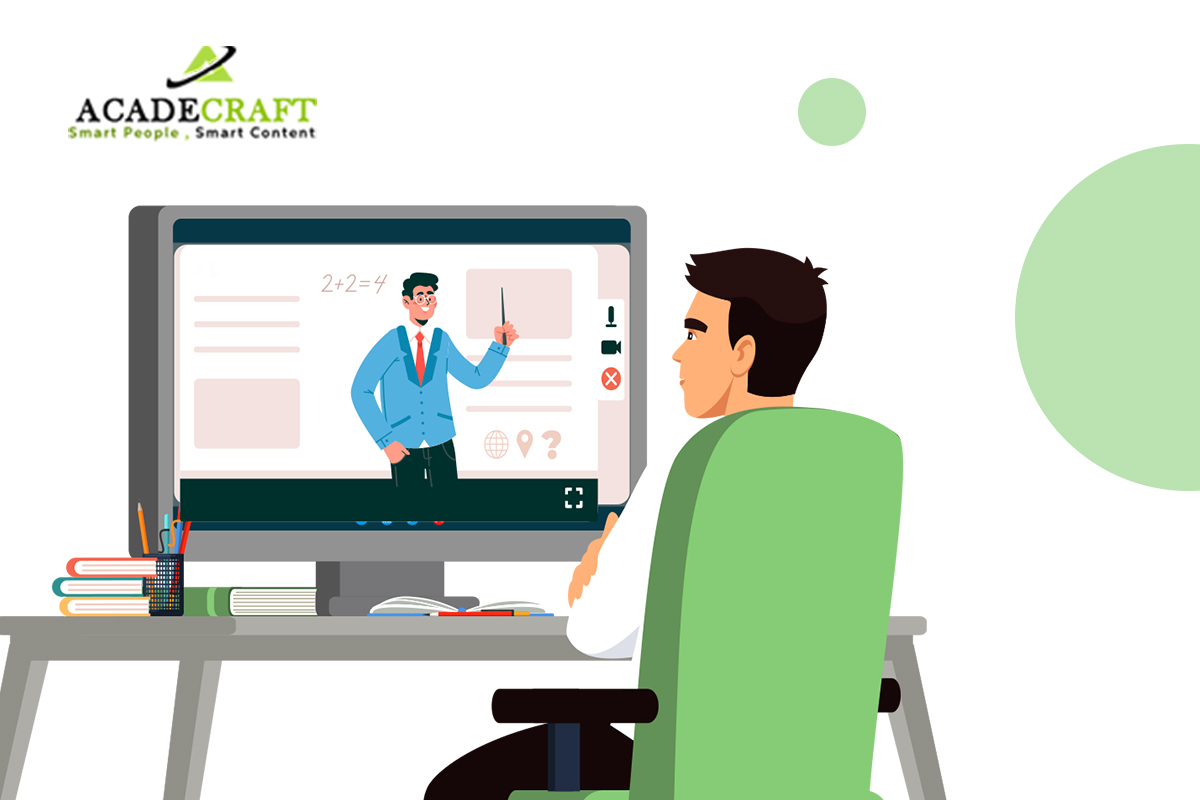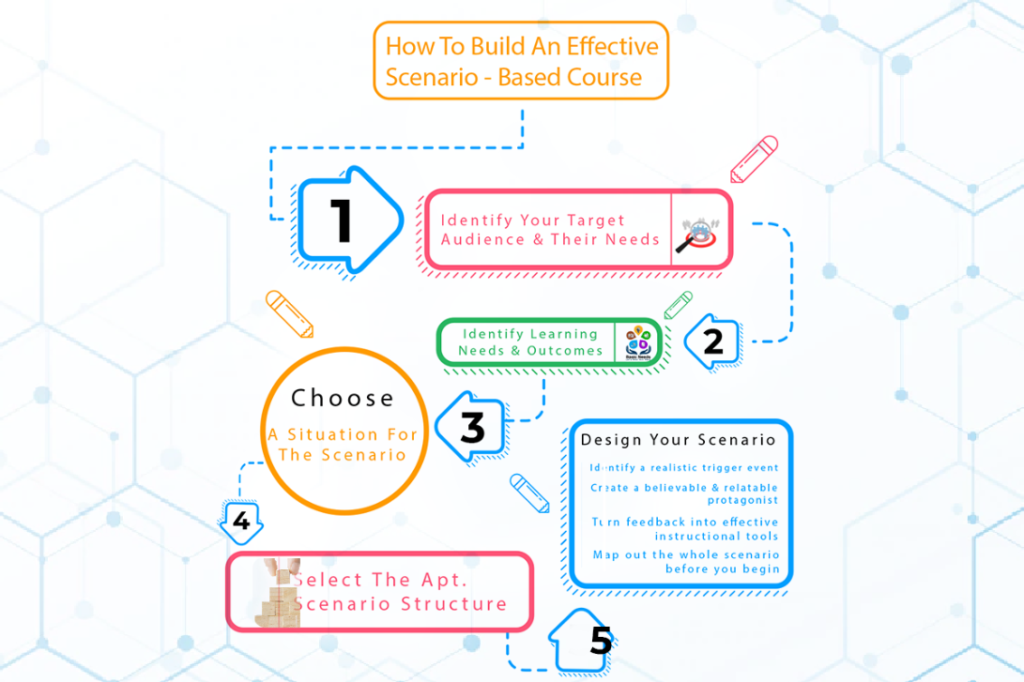
Think back to the last time you mastered a new skill. How much of your preparation came from merely reading training content? How much of it came from learning by doing it or trying it out for yourself?
Learning is a process, and the reflection and application phrase are key to cultivating confident, prepared learners. But it is not always safe, or even realistic, to teach new skills in the actual environments in which they are applicable.
That is where scenario-based elearning comes into picture!
Scenario-based learning (SBL) is an interactive instructional strategy that uses real-life narratives and situations to involve learners actively. SBL is a proven strategy to boost learning outcomes. What are the benefits?
You can use scenario based learning to create both informal and formal training solutions. Some advantages of this approach offers are mentioned below:
? Enables problem-solving in learners.
? Provides guided study to learners.
? Builds sticky learning experiences.
? Provides a safe practice zone to gain mastery and proficiency.
? Strengthen primary messaging.
? Allows learners to reinforce the right approach, make mistakes and through feedback.
Scenario Based Learning can be used to meet diverse corporate training needs. It is mostly used for
1. Soft skills training
2. Compliance training
3. Leadership training
4. Professional skills training
5. Application simulation training
Scenario based learning is generally used for performance support intervention, formal training, and online support. It can be used to deliver the following value:
? For improving retention
? For knowledge gain
? For triggering behavioral change
? For an effective application of learning on the job
The following is a 5 step plan to leverage the scenario based learning strategy for corporate training.

Step 1: Analyse the audience profile to ascertain what kind of approach would echo with them.
Step 2: Quantify the learning needs and, more precisely, the expected gains.
Step 3: Using the pointers of step 1 and step 2, recognize the approach and the structure of the scenarios.
Step 4: Classify the design formats to build the scenarios.
Step 5: Design Scenarios to provide detailed feedback and room to recalibrate based on the interim evaluation.
Scenarios aid learners understand how the knowledge they gain can be useful in a professional environment. The scenario can be related to a product or service sale to a prospective customer, day-to-day scenario, team-building exercise, customer insight or service experience, particular skill development, resolving common business issues, etc.
Scenarios help boost the interactivity of your eLearning courses by providing first-hand learning to the learners. By putting the learners in real-life scenarios, you can improve their understanding of the concepts, you can train them in certain key areas, etc.
A scenario based approach to training or learning can help learners immerse themselves in the course. With scenario based learning, you can make learning more interesting and engaging.
Here we will learn about some impactful and effective examples of scenario based learning:
1. Dialogue in scenarios create interest in learners
Compliance training can be dull for most learners. But it is compulsory training. Scenario based eLearning course involving newly joined employees and senior employees of the organization.
In these scenarios, the seniors meet the newly joined employee to educate them about mandatory compliance aspects. The scenario includes numerous dialogues between employees from diverse departments.
Learners find this approach fascinating, and the course completion rate was more than 95% (according to a study).2.? ? Cover safety training using real-world scenarios
It is important to maintain safety for employees in an organization. SBL is an essential way to train employees on safety aspects. Scenario based learning covers the significance of safety in the workplace, following the safety rules, how to confirm safety by using the correct equipment, having the appropriate plan to complete a task, etc.
The real-world scenarios are used to describe the various aspects of safety, the appropriate use of safety equipment, the need to have the right tools and systems in place, and so on. All the safety aspects are explained using engaging and interesting scenarios from the past and real world events.
3. Real life scenarios help engage the learner
Training videos can include realistic scenarios to explain the thoughts better to the learners. For example a retail customer service course, uses scenarios to depict real-world situations faced in sales. The scenarios are beautifully designed with the help of animated characters, real characters, and graphics.
Such scenarios can help the salesperson explain a service or product to a prospective buyer, motivate the customer, and close the sale.
4. Scenarios make skill training easy for your employees
Organizations can successfully use scenarios to provide specific skill training to your employees. Interesting scenarios provide engaging and fun experiences to the learners, making the training content more memorable, enjoyable, and engaging.
You can also introduce gaming elements, to further engage the learner.
5. Use Scenarios to explain technical knowledge
Businesses can use scenarios to convey technical knowledge to new joiners. Aspects like basics, functionality, etc can be covered by senior personnel.
The scenarios can be developed using multi-coloured icons, animated characters, and graphics to provide an immersive experience to learners.
For learning to be effective and really change the way we think and act, it needs to account for the way our brain absorbs and processes new information. The scenario examples serve as inspiration to show what is possible in training and eLearning.
Scenario based learning is powerful: learners can practice their skills, repeat the exercise until they get it right, and learn from the consequences. SBL helps employees handle similar situations effectively and acquire new skills. It helps build better retention and reinforce knowledge. It also helps employees sharpen skills like decision-making and critical thinking.
Are you looking for a scenario based learning solutions provider?Scenario based learning by Acadecraft helps in improving client relationships, learners in honing their communication skills, and enhancing their productivity. They help businesses in reducing expense and time of training by immersing the learners in the environment and real-life situations.
Share